Tables and Chairs to Live With
Thoughts on the physicality of education and scholarly work, and its workings in artistic research
Some Preliminary Conclusions
What brings all the elaborations on power relations together in this text is their refusal to be understood as either discursive or material. Instead, they suggest a material-discursive analysis, which brings to the fore what normally resides in the background: the physicality of education and scholarly work. Moreover, if we follow Foucault again, the subjects in these power relations do not precede their relations, but instead, are produced through these relations. Foucault calls this the concept and paradox of subjectivation: the very processes that enforce a subject’s subordination and correlation to certain norms, are the conditions through which she becomes a self-conscious identity and agent (Foucault, 1983, p.208-225). (*5) Foucault’s understanding of power is important for educational settings and scholarly work, because it neither conceptualizes the students, teachers, and scholars as blank pages for social inscription, nor as omnipotent masters of educational processes or scholarly work. His understanding of power does not reside in either subordination or resistance, but rather, tries to move beyond this binary construction through both subordination and resistance.
(*5) Foucault’s understanding of power is important for educational settings and scholarly work, because it neither conceptualizes the students, teachers, and scholars as blank pages for social inscription, nor as omnipotent masters of educational processes or scholarly work. His understanding of power does not reside in either subordination or resistance, but rather, tries to move beyond this binary construction through both subordination and resistance.
The collaborative research in, e.g., “Hidden Curriculum” touches upon this double approach by investigating the implicit knowledge in practices and objects in school that is hard to grasp as it is hidden by its common, everyday nature. This implicit knowledge is part of everyday life in school and shapes the way we relate to each other and to objects in school. On a more general level, the students’ investigations pose the question as to whether the way we sit on a chair (also in relation to other chairs and object) actually shapes (and restricts) the way we think and how we know these chairs. Through the investigative performances, the students ask not only what a hidden curriculum and the implicit knowledge might mean to them, but just as importantly, they examine what a hidden curriculum does in the realm of the school; how it is produced through our bodies and their material environment; and most importantly, how a hidden curriculum is connected to both processes of subordination and transformation.
Annette Krauss ( 2014): Tables and Chairs to Live With. Thoughts on the physicality of education and scholarly work, and its workings in artistic research. In: p/art/icipate – Kultur aktiv gestalten # 05 , https://www.p-art-icipate.net/tables-and-chairs-to-live-with/



 Artikel drucken
Artikel drucken